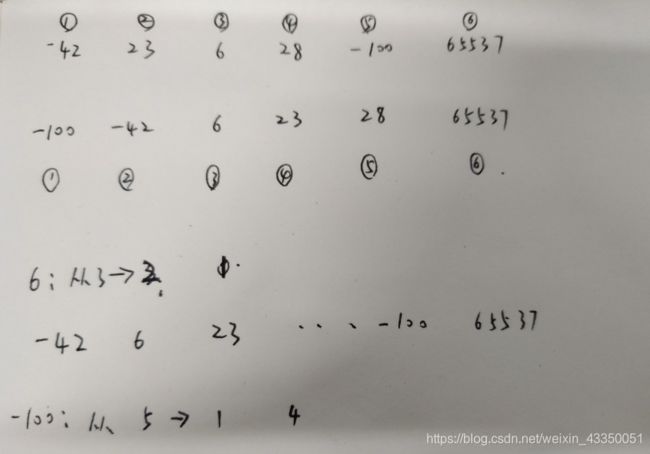Brainman(规律题)【数学思想】
Brainman
题目链接(点击)
| Time Limit: 1000MS | Memory Limit: 30000K | |
| Total Submissions: 12942 | Accepted: 6504 |
Description
Background
Raymond Babbitt drives his brother Charlie mad. Recently Raymond counted 246 toothpicks spilled all over the floor in an instant just by glancing at them. And he can even count Poker cards. Charlie would love to be able to do cool things like that, too. He wants to beat his brother in a similar task.
Problem
Here's what Charlie thinks of. Imagine you get a sequence of N numbers. The goal is to move the numbers around so that at the end the sequence is ordered. The only operation allowed is to swap two adjacent numbers. Let us try an example:
Start with: 2 8 0 3
swap (2 8) 8 2 0 3
swap (2 0) 8 0 2 3
swap (2 3) 8 0 3 2
swap (8 0) 0 8 3 2
swap (8 3) 0 3 8 2
swap (8 2) 0 3 2 8
swap (3 2) 0 2 3 8
swap (3 8) 0 2 8 3
swap (8 3) 0 2 3 8
So the sequence (2 8 0 3) can be sorted with nine swaps of adjacent numbers. However, it is even possible to sort it with three such swaps:
Start with: 2 8 0 3
swap (8 0) 2 0 8 3
swap (2 0) 0 2 8 3
swap (8 3) 0 2 3 8
The question is: What is the minimum number of swaps of adjacent numbers to sort a given sequence?Since Charlie does not have Raymond's mental capabilities, he decides to cheat. Here is where you come into play. He asks you to write a computer program for him that answers the question. Rest assured he will pay a very good prize for it.
Input
The first line contains the number of scenarios.
For every scenario, you are given a line containing first the length N (1 <= N <= 1000) of the sequence,followed by the N elements of the sequence (each element is an integer in [-1000000, 1000000]). All numbers in this line are separated by single blanks.
Output
Start the output for every scenario with a line containing "Scenario #i:", where i is the number of the scenario starting at 1. Then print a single line containing the minimal number of swaps of adjacent numbers that are necessary to sort the given sequence. Terminate the output for the scenario with a blank line.
Sample Input
4
4 2 8 0 3
10 0 1 2 3 4 5 6 7 8 9
6 -42 23 6 28 -100 65537
5 0 0 0 0 0Sample Output
Scenario #1:
3
Scenario #2:
0
Scenario #3:
5
Scenario #4:
0思路:
目的:给出序列让计算出 通过 相邻数字的移位 实现序列 从小到大排列 所需要的总移动次数
在给出的序列中 没有可以更多可以利用的条件 既然是要排序 就试着找排序后位次和现在的位次的关系:
例: 2 8 0 3 是已知的序列
排序后: 0 2 3 8
其中 2的位次变化: 1→2 差值: 1
8: 2→4 2
0: 3→1 -2
3: 4→3 -1
差值相加为零可以理解,但同号之间的关系是不是直接相加就可以?
用题目示例3:可以证明不对
仔细想了想是因为:(下面是模拟的过程)
如果用开始的方法直接相加结果是0+4
但其实是0+1+4:
因为-100 最终在6 的前面 所以6 的位置就会由3 变成4 然后4再变成3 这样是1 而不是0(看不懂直接看规律)
所以规律是:从前往后移动计算前后序号差之和再加上在该位置后面比它小或相等值的个数
例如: -42 23 6 28 -100 65537
4+0+1(在6后面有1个-100比它小)
AC代码:
#include
#include
using namespace std;
typedef long long LL;
const int MAX=1e3;
struct node{
LL count;
LL num1;
LL num2;
}edge[MAX+5];
int main()
{
LL b[MAX+5],T;
scanf("%lld",&T);
for(LL k=1;k<=T;k++){
LL n;
scanf("%lld",&n);
for(LL i=1;i<=n;i++){
scanf("%lld",&edge[i].count);
edge[i].num1=i;
b[i]=edge[i].count;
}
sort(b+1,b+n+1);
for(LL i=1;i<=n;i++){
for(LL j=1;j<=n;j++){
if(b[i]==edge[j].count){
edge[j].num2=i;
}
}
}
LL sum=0;
printf("Scenario #%lld:\n",k);
for(LL i=2;i<=n;i++){
if(edge[i].count=edge[j].count){
count1++;
}
}
sum+=(edge[i].num1+count1-edge[i].num2);
edge[i].count=edge[i-1].count;
}
}
printf("%lld\n\n",sum);
}
return 0;
}
